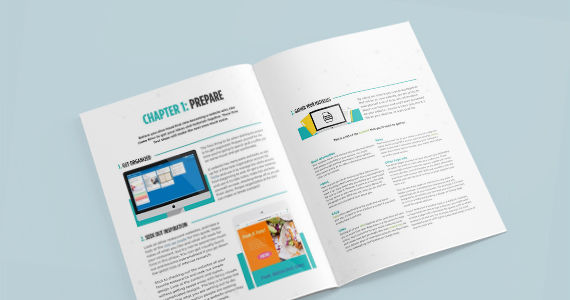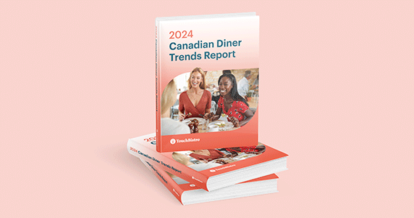You’ve painstakingly selected your chairs and booths, and now you’re faced with the task of filling them. Restaurant marketing is the key to your success, and a well-written restaurant marketing plan will make the execution of your strategy super easy.
So here it is: everything you need to know to write the perfect marketing plan for your family restaurant. In this article, we’ll walk you through all the components of a complete restaurant marketing plan – which you can of course tailor to the needs of your business.
To set you up for success, we’ve also put together a template you can download, customize, and fill in with your own marketing strategy. Take everything you learn here and follow along with your template – at the end of this process, you’ll be well on your way to creating an expert-level promotion strategy for your family restaurant.

Get your free, step-by-step template to bring in new customers and keep them coming back.
The Difference Between a Business Plan and a Marketing Plan
Before we talk about the components of a restaurant marketing plan, let’s talk about what it’s not: a business plan. Here are some key differences between a business plan and a marketing plan.
A business plan:
- Determines how you’ll run your business
- Specifies location, staffing, financing, etc.
- Outlines your vision for your restaurant’s future
A marketing plan:
- Acts as an instruction manual for promoting your business
- Sets goals and milestones for customer growth and retention
- Determines roles, responsibilities, and budget for promoting your restaurant
Keep your business plan handy as you build your restaurant marketing plan. The two documents – while distinctly different – should rely on each other like a codependent power couple.
Planning to Write Your Marketing Plan
Before you actually start writing your marketing plan, there are some items you should check off your to do list first. These items set you up to write an informed marketing plan that aligns with where your restaurant is positioned within the market and against your competitors. Here we’ll take you through all the elements you’ll need to prepare before you start writing your plan.
Competitor Analysis
Whether you beat ‘em or decide to join ‘em, you need to know what “‘em” are up to. Here’s what you need to do to conduct an effective competitor analysis.
- Sign up for your competitors’ e-newsletters
- Follow your competitors on social media
- Keep a spreadsheet of your competitors’ offers and promotions
- Then perform a formal competitive analysis: their channels, voice and tone, target audience, strengths, weaknesses, opportunities you have to beat them, and threats they may pose to your business
SWOT Analysis
You probably conducted a SWOT analysis of your own business when you wrote your restaurant business plan. If you did not, perform one now:
- List your business’ strengths: the things that make you stand out
- List your business’ weaknesses – and make sure to be brutally honest
- Write down any opportunities your restaurant has to stand out from the crowd, whether it’s a special kind of cuisine you offer or a guest experience feature no one can get anywhere else
- List any threats to your business, like your competitors or a change in your neighborhood
Compare your SWOT analysis to the ones you did for your competitors. Note any interesting overlap, and keep this information close at hand when you’re writing your marketing plan.
Marketing Plan Overview
Before diving into the nitty-gritty details of a marketing plan, you’ll want to remind yourself of your vision, goals, and target audience. Ideally, you can pull this information straight from your business plan. Here’s what you’ll need to include:
Mission statement: Your mission statement is the reason your restaurant exists. Mission statements are usually one to three sentences and approximately 50 words. They describe your restaurant’s value, inspire your customers, staff, and stakeholders, are plausible and realistic, and they are specific and to the point.
Elevator pitch: Your elevator pitch is how you would describe your restaurant to a stranger if you only had 60 seconds. Make sure you include your restaurant’s name, what type of food you offer, and what makes you unique.
Target audience: Describing your target audience can be fun. Some people like to create personas, which is a character who represents your target demographic and psychographics.
Voice and tone: Now that you’ve created your persona, how do you want to talk to them? Will your restaurant voice be more casual or formal? This is your chance to define a personality for your restaurant.
Goals: Not to get too existential, but what’s the point of all the work you’re doing here? You’ll want to list some tangible goals you can use to measure your overall success in your marketing efforts.
Some obvious examples are:
- Customer acquisition (XX% growth in 12 months)
- Customer retention (XX% by end of year)
- Local share of voice (XX media mentions this year)
You may have others, and that’s great! Just remember that as you go through the components of your marketing plan, you’ll want to return to these goals to make sure each elements of your strategy rolls up to one of these goals.

Writing Your Marketing Plan
Now that you’ve identified the who and why, it’s time to focus on the how and when. This next section is the heart and soul of your marketing plan.
As a family restaurant, you have the advantage of time with your guests. But customer experience isn’t limited to when your guests are actually sitting in your restaurant. Guest experience begins when diners decide to search for a place to eat, and ends … well, hopefully it never ends if you have a sound customer retention strategy!
For each section of your marketing plan, identify the following:
- Goal: Refer to your primary goals. Which goal will each particular tactic or strategy support?
- Audience: If you have a segmented audience, identify which segment you’re targeting with each marketing effort.
- Channels: Based on who you’re targeting, and which goal you’re aiming to meet, determine which channels you will have the most success reaching your audience with.
- Timeline: Key events and milestones you hope to hit throughout the year ahead.
- Measuring success: We’re talking tangible ways of measuring whether a marketing strategy is working or not. Key performance indicators.
- Roles and responsibilities: Who will execute on the elements of your strategy, and what will they do?
- Budget: Fairly self explanatory. List your budget line items for each tactic. Include a note about return on investment if you’ve done the research.
Note: Don’t feel pressured to execute on all the components of this plan! You know your capacity best, from budget to human resources. We’re giving you the full menu, but we also want to stress that you should prioritize what’s best for your business.
Public relations / media marketing
Media exposure is restaurant marketing gold, especially if you can secure some cool local media when you’re first starting out. But the thing is, you need to give journalists something to write about. So while PR and media marketing is about doing the legwork to get mentions, it’s mostly about creating a compelling story for your restaurant.
So how do you make your restaurant newsworthy? Here are some ideas:
- Story mining: Journalists usually do this – but they’ll love you if you can do it for them. Local events, celebrity guest chefs, expansions, or efforts to make your restaurant more environmentally sustainable – these are the kinds of stories local media outlets eat up (pun intended).
- Be a local expert: Whether you’re really into farm-to-table best practices or issues facing your community, the more publicly you speak to the issues you’re passionate about, the more journalists and bloggers will approach you for quotes when they’re running stories on your fave topics.
- Tap into trends: What’s trending? If you can draw a link between your restaurant and what’s hot in the news – a food craze, a new cooking technique, standing tables – you’ll be seen as newsworthy.
- Pull on heartstrings: A family of regulars who overcame something difficult, a leadership program for young staff, or a community partnership with your local meals-on-wheels program – make people feel something about your restaurant, and the media will follow.
Direct mail
The internet may have created an entire world of new ways to promote your restaurant to hungry families, but it has yet to make more traditional marketing methods obsolete. Direct mail may sound old school, but in this case, old school is still cool.
A direct mail campaign usually involves some sort of promotion or offer, but be aware that it can be expensive due to the cost of mailing lists and postage. But if you’re just starting out and want to raise a lot of awareness of your restaurant to a new audience, a direct mail campaign could be just the thing for you.
A successful direct mail campaign will:
- Allow you to track success – think coupons and promo items with discount codes.
- Drive people to your website and/or social media channels.
- Establish your brand as top of mind to your target audience
Events and community partnerships
For local family restaurants, events and community partnerships are essential for growing your brand and creating customer loyalty.
This may sound odd, but you’ll want to go back to your list of competitors for this one. You’ll want to get to know your fellow business owners, and maybe even consider collaborating with them on specific initiatives where you may both benefit. The advantage is that this can cost you next to nothing, and you can benefit from tapping into another restaurant’s customer base.
Events are another matter entirely. Depending on the event, participation may be costly and you may not be sure of the return on investment before you jump in. Make sure to talk to your restaurant friends to get good recommendations on which local events are worth your time.
Website and SEO
Your website is the online heart and soul of your restaurant. Also, just FYI, 86% of people look at restaurant menus before going out to eat – meaning the online menu on your website needs to look great.

A step-by-step guide for website planning and creation.
You’ll want to make sure you include certain key assets on your website to make it easy and enjoyable to navigate:
- Easy to find opening hours, location, and contact information
- High-quality photos of your restaurant and menu items
- A detailed and descriptive online menu
- Your restaurant’s history and mission statement
- Links to your social media profiles and online review site profiles
- An events and promotions calendar
When you’re designing your website, you should also be thinking about search engine optimization (SEO). SEO is the practice of optimizing your website so it ranks as high as possible when people are searching Google for places to eat.
On a basic level, here’s how to improve your search engine rankings:
- Optimize for relevant keywords
- Write effective title tags
- Include keywords in your meta descriptions

Social media
It wasn’t so long ago that social media marketing was viewed as cutting-edge. Today social media is a standard component of any marketing plan – which means your competitors are also vying for attention across channels.

Drive sales and brand awareness with our free social media templates for restaurants.
If you do nothing else, make sure you understand the quirks of every social media channel available to you before you start mapping out your strategy. Every channel comes with its own features, characteristics, and potential problems you’ll need to be aware of.
Instagram, for example, is a no brainer for restaurants, given that we eat with our eyes and people love to look at beautiful pictures of food. Twitter, however, requires constant monitoring and maintenance, so you may not want to invest in the channel if you’re not properly resourced. And while Google+ may seem like a backwater social media channel that basically no one uses, just having a presence on the channel has been said to boost search rankings.
So make sure you carefully consider your goals and the conversations you want to be a part of on social media. This will help you focus your efforts when you’re mapping out what should be a significant portion of your overall marketing strategy.
Email is a direct link to customers who are invested in your restaurant. If a customer has gone so far as to provide you with their email address, it means they care enough about your restaurant to want to know about its success, promos, and events.
But how do you go about collecting customers’ email addresses to get started? Here are some tips:
- Place an email newsletter subscription button on your website
- Cross-promote your email newsletter across your social media channels and direct mail campaigns
Online review sites
Word of mouth is nothing new, and it’s tried and true.
You provide customers with an experience, they talk to their friends about that experience, then those people either choose to visit your restaurant or stay away.
Restaurant review sites are just word of mouth through the world’s biggest megaphone.
Most restaurant-goers regularly look at online reviews to help them make decisions about where to eat. So it’s safe to say you should be taking the time to claim your business on restaurant review sites.
Here are some of the reasons why you should claim your business on restaurant review sites:
- Be found: Ensure your business information (address, website, contact info, hours, menu) is up to date so people searching by location or category can find you.
- Boost search rankings: The more reviews your business has, the higher your business will rank on Google. When searching, users usually only look at the first few search results, so it’s important you rank as highly as possible.
- Build relationships with customers: Thanking positive reviewers is a great way to solidify their great experience with you. And when you address issues raised in a negative review, you’ll be more likely to turn a displeased customer’s opinion around.
- Improve your business: Reviews tell you how customers experience your restaurant. When you’re paying attention to online reviews, you’re getting insight into what’s working and what’s not, so you know which menu items to promote and how to improve customer experience.
- Reward your employees: Reviewers sometimes mention servers by name. If you start to notice a pattern, reward your star employees for their amazing performance!
Remember that no two restaurant marketing plans are the same – you’ll want to prioritize marketing efforts that are the most important to your restaurant based on your budget, time, and resources. But also don’t be afraid to take some risks, as you’ll need to test certain initiatives before you can know whether or not they worked. Make sure to fail fast, learn, and optimize your efforts for the next round.

Get your free, step-by-step template to bring in new customers and keep them coming back.
Free social media templates for your restaurant







